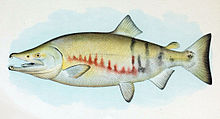Chum Salmon
| Chum salmon | |
|---|---|
 |
|
| Scientific classification | |
| Kingdom: | Animalia |
| Phylum: | Chordata |
| Class: | Actinopterygii |
| Order: | Salmoniformes |
| Family: | Salmonidae |
| Genus: | Oncorhynchus |
| Species: | O. keta |
| Binomial name | |
|
Oncorhynchus keta (Walbaum, 1792) |
|
| Nutritional value per 100 g (3.5 oz) | |
|---|---|
| Energy | 502 kJ (120 kcal) |
|
0 g
|
|
| Dietary fiber | 0 g |
|
3.77 g
|
|
| Saturated | 0.84 g |
| Monounsaturated | 1.541 g |
| Polyunsaturated | 0.898 g |
|
20.14 g
|
|
| Tryptophan | 0.226 g |
| Threonine | 0.883 g |
| Isoleucine | 0.928 g |
| Leucine | 1.637 g |
| Lysine | 1.849 g |
| Methionine | 0.596 g |
| Cystine | 0.216 g |
| Phenylalanine | 0.786 g |
| Tyrosine | 0.68 g |
| Valine | 1.037 g |
| Arginine | 1.205 g |
| Histidine | 0.593 g |
| Alanine | 1.218 g |
| Aspartic acid | 2.062 g |
| Glutamic acid | 3.006 g |
| Glycine | 0.967 g |
| Proline | 0.712 g |
| Serine | 0.822 g |
| Vitamins | |
| Vitamin A equiv. |
(4%)
30 μg |
| Thiamine (B1) |
(7%)
0.08 mg |
| Riboflavin (B2) |
(15%)
0.18 mg |
| Niacin (B3) |
(47%)
7 mg |
| Pantothenic acid (B5) |
(15%)
0.75 mg |
| Vitamin B6 |
(31%)
0.4 mg |
| Folate (B9) |
(1%)
4 μg |
| Vitamin B12 |
(125%)
3 μg |
| Vitamin C |
(0%)
0 mg |
| Vitamin E |
(7%)
1.09 mg |
| Minerals | |
| Calcium |
(1%)
11 mg |
| Iron |
(4%)
0.55 mg |
| Magnesium |
(6%)
22 mg |
| Manganese |
(1%)
0.015 mg |
| Phosphorus |
(40%)
283 mg |
| Potassium |
(9%)
429 mg |
| Sodium |
(3%)
50 mg |
| Zinc |
(5%)
0.47 mg |
| Other constituents | |
| Water | 75.38 g |
| Alcohol (ethanol) | 0 g |
|
|
| Percentages are roughly approximated using US recommendations for adults. Source: USDA Nutrient Database |
|
The chum salmon (Oncorhynchus keta) is a species of anadromous fish in the salmon family. It is a Pacific salmon, and may also be known as dog salmon or keta salmon, and is often marketed under the name silverbrite salmon. The name chum salmon comes from the Chinook Jargon term tzum, meaning "spotted" or "marked", while keta in the scientific name comes from the Evenki language of Eastern Siberia via Russian.
The body of the chum salmon is deeper than most salmonid species. In common with other species found in the Pacific, the anal fin has 12 to 20 rays, compared with a maximum of 12 in European species. Chum have an ocean coloration of silvery blue green with some indistinct spotting in a darker shade, and a rather paler belly. When they move into fresh water the color changes to dark olive green and the belly color deepens. When adults are near spawning, they have purple blotchy streaks near the caudal peduncle, darker towards the tail. Spawning males typically grow an elongated snout or kype, their lower fins become tipped with white and they have enlarged teeth. Some researchers speculate these characteristics are used to compete for mates.
Most chum salmon spawn in small streams and intertidal zones. Some chum travel more than 3,200 km (2,000 mi) up the Yukon River. Chum fry migrate out to sea from March through July, almost immediately after becoming free swimmers. They spend one to three years traveling very long distances in the ocean. These are the last salmon to spawn (November to January) in some regions. In Alaska they are the first to spawn in June and August and are then followed by pink and coho salmon. They die about two weeks after they return to the freshwater to spawn. They utilize the lower tributaries of the watershed, tend to build nests called redds, really little more than protected depressions in the gravel, in shallow edges of the watercourse and at the tail end of deep pools. The female lays eggs in the redd, the male sprays milt on the eggs, and the female covers the eggs with gravel. The female can lay up to 4000 eggs.
...
Wikipedia
